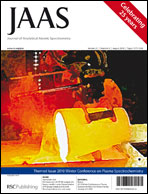Owing to the shorter time interval during which energy is delivered to the sample material, femtosecond (fs) laser ablation is preferable over nanosecond laser ablation for metallic samples. In this project, the influence of various laser parameters—beam diameter, repetition rate and laser fluence—on the ablation of Pb as a heavy metallic matrix using an infrared (λ = 795 nm) fs-LA system (150 fs pulse duration) was studied. The merits of Ar and He as carrier gases were compared and as He did not provide a substantial improvement in the limits of detection, while deposition of sample material on the window of the ablation chamber was more pronounced, Ar was selected for all further measurements. The effect on the ICP caused by the introduction of various amounts of sample aerosol was studied by monitoring the signal intensity for 38Ar+. It was shown that maximizing the amount of sample ablated and thus, the amount of sample aerosol introduced into the ICP, did not result in maximum sensitivity, which was rather obtained under ‘compromise’ conditions. Subsequently, femtosecond LA-quadrupole-based ICP-mass spectrometry (ICP-MS) was used for the determination of traces of the platinum group metals (PGMs) Rh, Pd, Ru, Ir and Pt and of Au in Pb buttons obtained by fire assay of platiniferous ore reference materials. The signal of 204Pb+ was used as an internal reference, correcting for variations in the laser ablation and transport efficiencies and in the instrument's sensitivity. The spectral interferences established for some of the target nuclides due to the occurrence of Pb2+ ions were successfully overcome by pressurizing the reaction cell with NH3. Quantification versus a calibration curve constructed on the basis of the results obtained for matrix-matched standards (> 99% Pb) provided excellent accuracy, superior to those obtained using nanosecond LA-ICP-MS. Also the limits of detection were improved by a factor ranging between 3 and 10 and are <0.010 μg g−1 for the most important PGMs (Rh, Pd, Pt) and Au. Several measures, such as the use of a large ablation cell and housing up to 10 Pb buttons, were taken to increase the sample throughput. In the same context, day-to-day reproducibility of the calibration curve was also examined. When recording a ‘fresh’ calibration curve every day, the average bias between the experimental results and the corresponding reference values was established to be <2.5% for every target element. When using one calibration curve during three consecutive days, the bias still remains <10%, while the sample throughput is increased and analysis of several tens of buttons per day is feasible (10–15 min total analysis time per sample).


 Please wait while we load your content...
Please wait while we load your content...